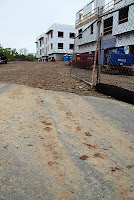Is the greenway project stopping all erosion? Or just a fraction? These are the kinds of questions asked when you take a watershed approach.
Erosion is a serious problem because sooner or later, it requires costly maintenance, and because it pollutes our lakes.
Cutting to the chase--I'll show below that the greenway project is will stop only a fraction of the erosion. Clearly, a comprehensive watershed approach is needed.
Below, I list the "offenders," with the worst listed first.
The streets themselves
Although it's not strictly erosion--much organic matter (and sand during the winter) washes from the streets. Street sweeping is the first line of defense, followed by the catchment basins found in many neighborhoods.
I watched a Vactor truck working. They opened a trap door in the street, and proceeded to vacuum out the sediment. Pipes from each nearby storm sewer empty into this basin, which was about the size of a closet.
Vactor truck working to remove storm sewer sediment.
There are some large sedimentation basins, like the pond at the base of Glenway St. that protects Lake Wingra. These are the last line of defense.
I found so much organic matter washing into storm sewers, that it's clear we aren't doing enough here. What about enabling and educating residents to gather the piles of organic matter, after a storm, and have it picked up by the city?
Woodland Park below Glenway Golf Course
Here there are numerous broad paths, which are eroding in places and need a covering of wood chips. While the area of pathways is large, they seldom discharge directly to a storm channel.
In addition, up near the golf course, there is an eroding gully. A large rain garden is needed to receive runoff from the Golf Course.
Gully forming just below Glenway Golf Course
Glenwood Children's Park
This neglected park has some severely eroded slopes, probably caused by children running up and down. It's a favorite wild play area. Happily, some of the trails in the park have recently been covered with wood chips.
Glenwood Children's Park--erosion caused by many little feet.
MG&E Glenway Substation
MG&E Glenway Substation--substantial erosion.
When an electric pole was changed last summer, a steep slope of the bikeway, next to the substation, was left denuded. Now it's covered with unsightly weeds and there's an eroding channel at it's base, which is discharging directly to a stormwater drain.
Reconstruction of Midvale Blvd
Grass was not well-established on the median of Midvale Blvd, and the area adjacent to the curb is starting to erode. While this erosion isn't especially severe in any one spot, the median strip is long, and the sediment goes directly to storm drains.
The city might reply, "Give us a break--it's early in the year, the grass will grow." Yes, but early in the year is exactly when you should expect erosion to occur.
The city might reply, "Give us a break--it's early in the year, the grass will grow." Yes, but early in the year is exactly when you should expect erosion to occur.
Krupp Construction at Sequoia Commons
Muddy tracks from Krupp construction at Sequoia Commons.
However, vehicle traffic to and from the site was tracking substantial amounts of mud onto the streets. From there, it goes straight to the lakes. So, Krupp gets an A- on sediment dams, but only a C on tracking mud onto the streets.
Madison erosion control ordinances require that a construction site has a gravel apron clean enough to avoid tracking mud onto the streets. If muddy tracks do occur, then the construction company must clean up the mud on streets by the end of the day. Krupp dropped the ball here.
Schools (Queen of Peace and Midvale Elementary)
Queen of Peace Church/School parking lot--eroded playground in rear.
Where children run and play, they often cause erosion. The problem comes when the eroding soil discharges directly onto pavement. At Midvale School, much of the erosion is buffered by grassy areas, but at the Queen of Peace school, the erosion discharges directly into the large parking lot, then heads to the lake.
Residential Gardens
Rain garden needed! Water from this downspout on Keating Ter. flows across a denuded garden, then into the street.
I did see a number of gardens that were still bare-- eroding and discharging their sediment onto the streets. Some of these gardens were located on the terraces. There are a few such houses per block. It's hard to say how big the problem is. Each source is small, so it depends on how many there are. One solution: apply mulch when ground is bare in the spring.
How you can help
Report erosion problems to the City here.
Monitor a construction site in your neighborhood, and report problems to Tim Troester 267-1995.
Direct your downspout into a rain garden. Info on rain gardens.
My survey methods
I walked around the Westmorland and Sunset Village neighborhoods, on May 12 after two nights of rain. The night of May 10 had moderately heavy rain. I looked for bare soil, gullies, and especially, signs of sediment in the street gutters. I don't pretend to have surveyed all spots, but I did probably find a cross section of the main offenders. The areas I looked at all drain into Lake Wingra, or into L. Mendota via Willow Creek.
In judging how bad a source is, I took into account the eroding area, plus the severity of the erosion. And if the eroded soil dumps directly onto pavement, then that magnifies the "sediment score," because that sediment goes straight to the lakes (or to a catchment basin which must be cleaned).
Go here for a slide show of the sediment sources.



















No comments:
Post a Comment
Please feel free to comment on the article above, or on other watershed issues.